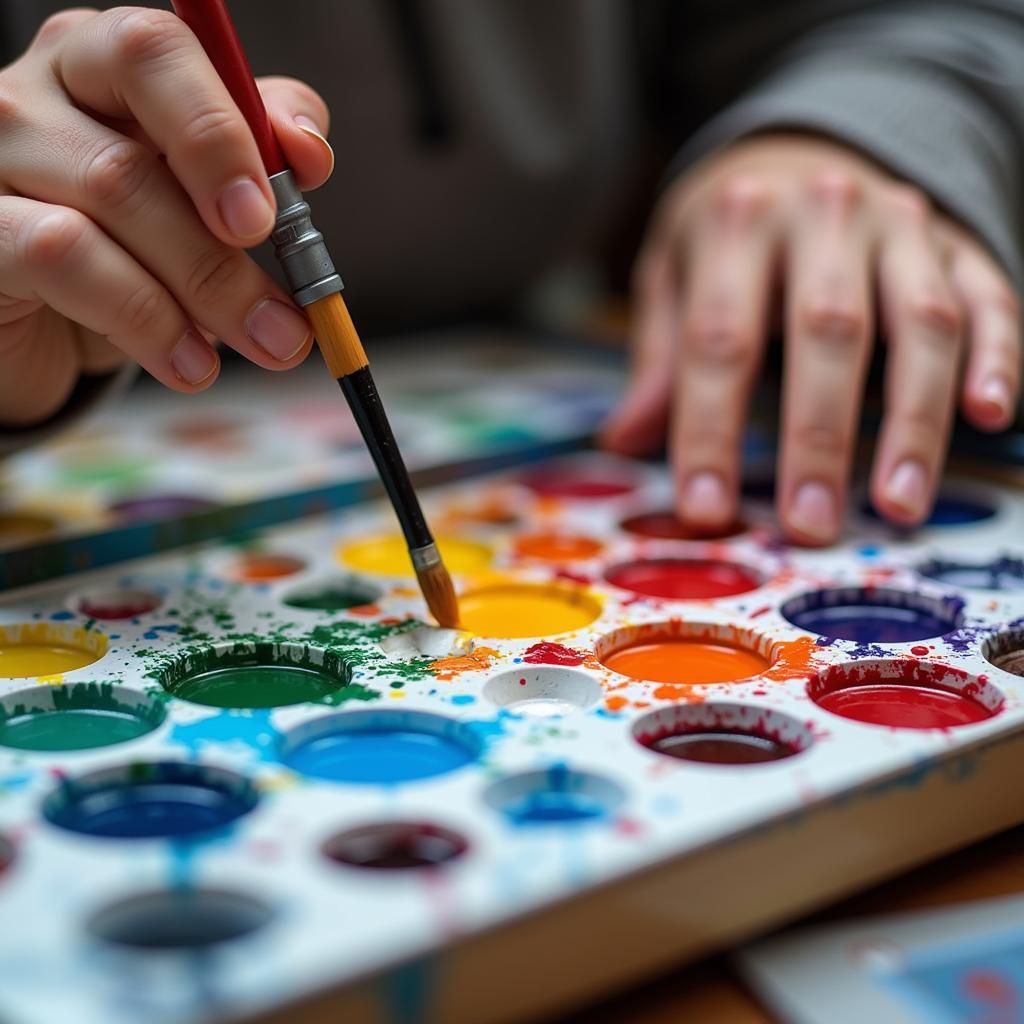Mixing paint colors can seem like a daunting task, especially for beginners. However, understanding the basics of color theory and using a few simple techniques can empower you to create an endless spectrum of hues and shades for your artistic endeavors. Whether you’re an experienced painter or just starting out, this comprehensive guide will equip you with the knowledge and confidence to mix painting colors like a pro.
Understanding the Color Wheel
The color wheel is a fundamental tool for understanding color relationships and mixing colors effectively. It consists of primary, secondary, and tertiary colors arranged in a specific order.
-
Primary Colors: Red, blue, and yellow are the primary colors. These are the foundation of all other colors and cannot be created by mixing other hues.
-
Secondary Colors: Orange, green, and violet are the secondary colors. They are created by mixing two primary colors in equal proportions. For example, mixing red and yellow creates orange.
-
Tertiary Colors: Tertiary colors are created by mixing a primary color with an adjacent secondary color. Examples include red-orange, yellow-green, and blue-violet.
Basic Color Mixing Principles
Before delving into specific color combinations, it’s crucial to grasp some fundamental color mixing principles:
-
Hue: Hue refers to the pure form of a color, such as red, blue, or green.
-
Saturation: Saturation describes the intensity or purity of a color. A highly saturated color appears vibrant, while a less saturated color appears duller.
-
Value: Value refers to the lightness or darkness of a color. Adding white lightens a color (creating a tint), while adding black darkens it (creating a shade).
-
Complementary Colors: Colors opposite each other on the color wheel are complementary. When mixed, they neutralize each other, creating a gray or brown tone. However, when placed side by side, they create a strong visual contrast.
-
Analogous Colors: Analogous colors are adjacent to each other on the color wheel. They create harmonious and pleasing color schemes.
Essential Color Mixing Tips
Here are some essential tips to enhance your color mixing skills:
-
Start with Small Amounts: Begin by mixing small quantities of paint. You can always add more to achieve the desired hue or value.
-
Gradual Mixing: Gradually add one color to another while mixing thoroughly. This allows you to control the intensity and prevents over-mixing, which can lead to muddy colors.
-
Test on a Palette: Always test your mixed colors on a palette or scrap paper before applying them to your canvas. This helps you visualize the final result and make any necessary adjustments.
-
Keep Notes: Keep a color mixing journal to record your successful recipes and experimentations. This will save you time and effort in the future.
Creating Specific Colors
How to Mix Acrylic Colors for Painting
Acrylic paints are versatile and widely used for their fast drying time and vibrant colors. Here’s a guide to mixing some popular acrylic colors:
-
Brown: Red and green, orange and blue, or yellow, red, and blue. Adjust the ratio of each color to achieve different shades of brown.
-
Purple: Red and blue. Vary the proportions to create different shades, such as lavender (more blue) or magenta (more red).
-
Pink: Red and white. Add small amounts of red to white until you achieve the desired pink shade.
-
Gray: Black and white. Adjust the ratio to create different shades of gray. You can also mix complementary colors to achieve a neutral gray.
 Mixing Acrylic Paints on a Palette
Mixing Acrylic Paints on a Palette
FAQs About Mixing Painting Colors
Q: What are the best paints for beginners to learn color mixing?
A: Acrylic paints are a great option for beginners as they are water-based, easy to clean up, and dry quickly.
Q: How do I make a color lighter without using white?
A: You can lighten a color by adding small amounts of its complementary color. For example, add a touch of green to red to lighten it slightly.
Q: Can I mix oil paints and acrylic paints?
A: It’s not recommended to mix oil and acrylic paints as they have different chemical compositions and drying times, which can lead to cracking or other undesirable effects.
Q: What is the best way to clean my brushes after mixing colors?
A: For water-based paints like acrylics, use soap and water. For oil paints, use a solvent specifically designed for cleaning oil paintbrushes.
Need More Color Inspiration?
Explore our other helpful articles on color mixing:
Unleash Your Inner Artist
Mastering the art of mixing painting colors opens up a world of creative possibilities. By understanding color theory, practicing different techniques, and experimenting with various combinations, you can achieve a rich and dynamic palette that brings your artistic vision to life. Remember, the journey of color mixing is an ongoing exploration. Embrace the process, have fun, and let your creativity flow!
For personalized guidance and expert advice on color selection and application, contact Color Box Hanoi. Our team of color specialists is dedicated to helping you create stunning and inspiring spaces that reflect your unique style and vision.
Call us at: 0373298888
Email us at: [email protected]
Visit us at: 86 Cầu Giấy, Hà Nội
We’re available 24/7 to assist you with all your color needs!
